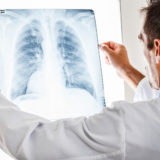Lung Cancer Basics

This article originally appeared on www.healthline.com
About lung cancer
Lung cancer originates in your lungs but can spread to other parts of your body. Cancer that begins elsewhere but spreads to your lungs isn’t lung cancer.
According to the National Cancer Institute (NCI), lung cancer is the second most diagnosed cancer in the United States. Smoking is the leading cause of lung cancer, but nonsmokers can get it too. The rate of new lung cancer diagnoses has been slowly declining since 2001. According to the NCI, this decline is similar to the decline seen in smoking rates.
Anyone can get lung cancer, but certain factors put you at greater risk. Smoking is the number one risk factor. You’re also at increased risk if you have a family history of lung cancer, especially if one of your parents or siblings had it.
Other dangers include exposure to:
- secondhand smoke
- radon gas
- asbestos
Substances like arsenic, nickel, and chromium can also pose a risk. Smokers who are exposed to additional cancer-causing agents are at an even greater risk.
People with early stage lung cancer often are unaware of an issue. As the cancer grows, a chronic cough may develop. Smokers may notice a change in their “smoker’s cough” or may start coughing up blood. Many people report:
- hoarseness
- wheezing
- frequent shortness of breath
- chest pain
- bone pain
- headache
Unexplained weight loss is also a common symptom of cancer.
Imaging tests like an X-ray or CT scan can help diagnose lung cancer. Mucus from your lungs can be analyzed for cancer cells (sputum cytology). Your doctor can also perform a biopsy, taking a tissue sample for analysis under a microscope.
Your doctor can get lung tissue by inserting a needle through your chest and into the lung (needle biopsy). Or they can acquire a lymph node sample with a surgical instrument that’s inserted through an incision at the base of your neck (mediastinoscopy).
Your doctor may also do a bronchoscopy to examine your lungs. In a bronchoscopy, a lighted tube with a small camera attached is passed through your nose, down your throat, and into your lungs.
Stages describe how far the cancer has progressed and where it has spread. Stage 1 means the tumor is less than 5 centimeters (cm) and hasn’t spread outside the lung. Stage 2 means the tumor is larger than 5 cm. Or it could also mean the tumor is smaller, but nearby tissues like the diaphragm, chest wall, or lymph nodes are affected.
In stage 3, the tumor is larger and has invaded nearby organs. It can also indicate a smaller tumor along with the presence of lung cancer cells in distant lymph nodes. Stage 4 is when cancer spreads to the second lung or more distant areas.
Your treatment options depend on details unique to you. Surgery is often necessary to remove the tumor and some surrounding tissue, part of the lung or airways, or the whole lung.
Chemotherapy uses powerful drugs to kill cancer cells throughout your body. Radiation therapy also kills cancer cells and can target specific areas.
It’s not always possible to know if there are any cancer cells left in your body, so your doctor may recommend a combination of treatments.
Other treatments
Laser therapy uses a narrow beam of light to kill cancer cells, and photodynamic therapy combines laser light with drugs. Cryosurgery freezes and destroys abnormal tissue, and electrocautery treatment uses a needle heated by an electric current to kill cancer cells. Monoclonal antibodies and tyrosine kinase inhibitors are target therapies that prevent cancer cells from growing.
You may want to ask your doctor about clinical trials used to test newer cancer treatments.
Many people with cancer find comfort in local support groups.
Shortness of breath and pain can impact your quality of life. Lung cancer can also cause you to cough up blood.
Another complication is fluid accumulating in the area around your lung (pleural effusion). If that happens, you’ll need to have fluid drained from your chest.
A serious complication of lung cancer is metastasis, when cancer spreads to distant areas like the brain, liver, adrenal glands, or bones. Metastatic cancer can cause a wide variety of symptoms, including increased pain. Various treatments can help manage symptoms.
Lung cancer can be fatal. According to the Centers for Disease Control and Prevention, it’s the leading cause of cancer deaths in the United States. However, it’s important to note that your long-term outlook depends on many factors, including your overall health, age, and choice of treatment. The stage of the cancer at diagnosis is an important factor when considering your outlook. The highest survival rates are for people whose lung cancer is diagnosed during stage 1 or stage 2, so it’s easier to treat if detected early on.
Dr. Peter Mikhail treats patients suffering from lung cancer in the Tampa, Clearwater, and New Port Richey areas of Florida. Call him to book an appointment for an evaluation of condition at 727-312-4844. You may be a good candidate for the da Vinci Surgical System.


